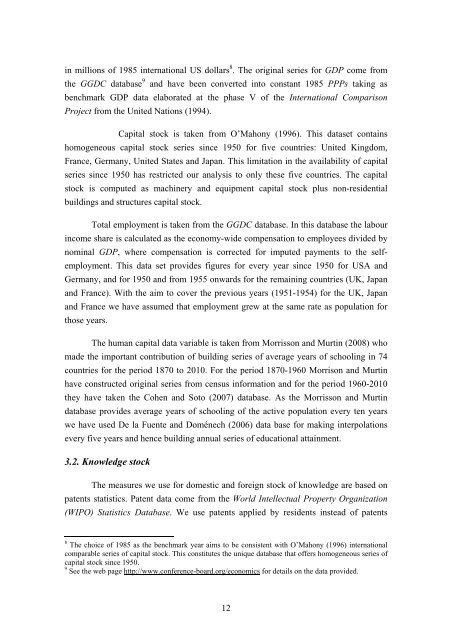You also want an ePaper? Increase the reach of your titles
YUMPU automatically turns print PDFs into web optimized ePapers that Google loves.
in millions of 1985 international US dollars 8 . The original series for GDP come from<br />
the GGDC database 9 and have been converted into constant 1985 PPPs taking as<br />
benchmark GDP data elaborated at the phase V of the International Comparison<br />
Project from the United Nations (1994).<br />
Capital stock is taken from O’Mahony (1996). This dataset contains<br />
homogeneous capital stock series since 1950 for five countries: United Kingdom,<br />
France, Germany, United States and Japan. This limitation in the availability of capital<br />
series since 1950 has restricted our analysis to only these five countries. The capital<br />
stock is computed as machinery and equipment capital stock plus non-residential<br />
buildings and structures capital stock.<br />
Total employment is taken from the GGDC database. In this database the labour<br />
income share is calculated as the economy-wide compensation to employees divided by<br />
nominal GDP, where compensation is corrected for imputed payments to the selfemployment.<br />
This data set provides figures for every year since 1950 for USA and<br />
Germany, and for 1950 and from 1955 onwards for the remaining countries (UK, Japan<br />
and France). With the aim to cover the previous years (1951-1954) for the UK, Japan<br />
and France we have assumed that employment grew at the same rate as population for<br />
those years.<br />
The human capital data variable is taken from Morrisson and Murtin (2008) who<br />
made the important contribution of building series of average years of schooling in 74<br />
countries for the period 1870 to 2010. For the period 1870-1960 Morrison and Murtin<br />
have constructed original series from census information and for the period 1960-2010<br />
they have taken the Cohen and Soto (2007) database. As the Morrisson and Murtin<br />
database provides average years of schooling of the active population every ten years<br />
we have used De la Fuente and Doménech (2006) data base for making interpolations<br />
every five years and hence building annual series of educational attainment.<br />
3.2. Knowledge stock<br />
The measures we use for domestic and foreign stock of knowledge are based on<br />
patents statistics. Patent data come from the World Intellectual Property Organization<br />
(WIPO) Statistics Database. We use patents applied by residents instead of patents<br />
8 The choice of 1985 as the benchmark year aims to be consistent with O’Mahony (1996) international<br />
comparable series of capital stock. This constitutes the unique database that offers homogeneous series of<br />
capital stock since 1950.<br />
9 See the web page http://www.conference-board.org/economics for details on the data provided.<br />
12

















